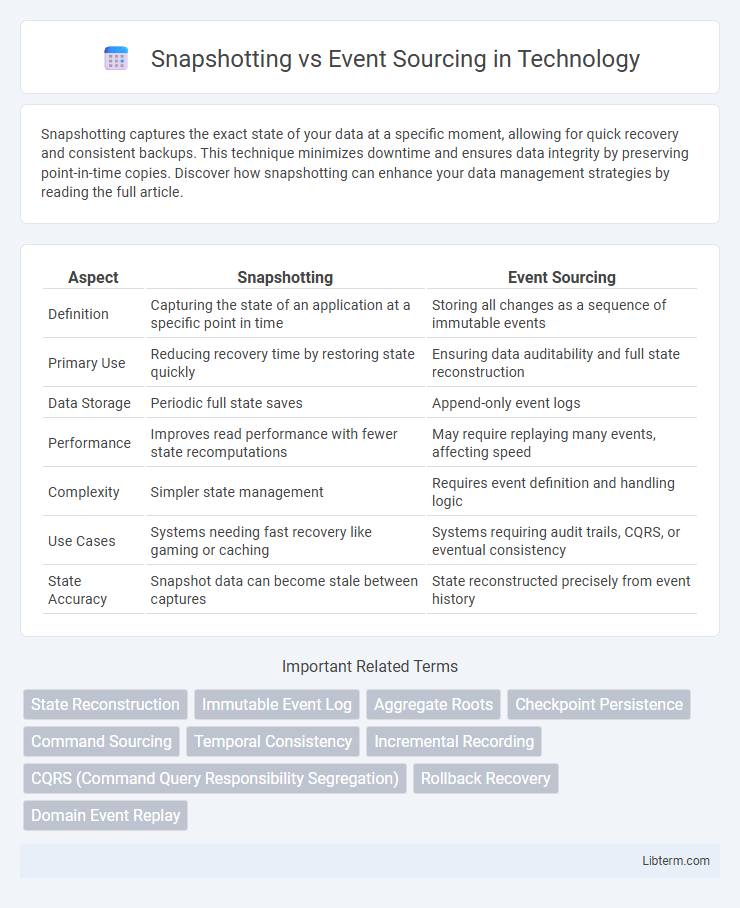Snapshotting captures the exact state of your data at a specific moment, allowing for quick recovery and consistent backups. This technique minimizes downtime and ensures data integrity by preserving point-in-time copies. Discover how snapshotting can enhance your data management strategies by reading the full article.
Table of Comparison
| Aspect | Snapshotting | Event Sourcing |
|---|---|---|
| Definition | Capturing the state of an application at a specific point in time | Storing all changes as a sequence of immutable events |
| Primary Use | Reducing recovery time by restoring state quickly | Ensuring data auditability and full state reconstruction |
| Data Storage | Periodic full state saves | Append-only event logs |
| Performance | Improves read performance with fewer state recomputations | May require replaying many events, affecting speed |
| Complexity | Simpler state management | Requires event definition and handling logic |
| Use Cases | Systems needing fast recovery like gaming or caching | Systems requiring audit trails, CQRS, or eventual consistency |
| State Accuracy | Snapshot data can become stale between captures | State reconstructed precisely from event history |
Introduction to Snapshotting and Event Sourcing
Snapshotting captures and stores the current state of an application at specific points in time, enabling faster data retrieval by avoiding the need to replay all historical events. Event Sourcing records every change as a sequence of immutable events, reconstructing the application's state by replaying these events in order. Combining snapshotting with event sourcing enhances performance by allowing quick state recovery from the latest snapshot while maintaining a complete event audit trail.
Core Principles of Snapshotting
Snapshotting involves capturing the entire state of an application at a specific point in time to optimize data retrieval and performance. It reduces the overhead of replaying a long sequence of events by storing a concise summary of the current state, enabling faster recovery in event-sourced systems. Core principles include maintaining consistency between snapshots and events, ensuring snapshots represent valid application states, and balancing snapshot frequency to optimize storage and processing efficiency.
Understanding Event Sourcing Fundamentals
Event sourcing captures all changes to an application's state as a sequence of immutable events, enabling precise state reconstruction by replaying these events. Snapshotting complements event sourcing by periodically saving the current state, reducing the need to replay the entire event log for faster recovery and improved performance. Understanding event sourcing fundamentals involves grasping event immutability, event stores, and the role of snapshots in balancing system efficiency and consistency.
Comparing Data Storage Approaches
Snapshotting stores the current state of an application at specific intervals, reducing the need to replay the entire event history for state reconstruction. Event sourcing captures every change as an immutable event, preserving the full sequence of state transitions to ensure auditability and traceability. While snapshotting optimizes read performance by minimizing replay time, event sourcing provides a comprehensive and granular data model ideal for complex domain logic and debugging.
Performance Considerations: Snapshotting vs Event Sourcing
Snapshotting improves read performance by storing periodic system states, reducing the need to replay entire event logs in event sourcing. Event sourcing offers detailed audit trails but can incur higher latency during state reconstruction due to sequential event playback. Balancing snapshot frequency and event log size is crucial for optimizing system responsiveness and resource utilization.
Scalability and System Complexity
Snapshotting improves scalability by reducing the number of events needed to rebuild an application's state, minimizing read latency and storage overhead in event-sourced systems. Event sourcing inherently increases system complexity due to the need to manage event streams, handle event ordering, and maintain eventual consistency across distributed components. Combining snapshotting with event sourcing balances performance and complexity by enabling faster state recovery while preserving a complete event history for auditing and debugging.
Use Cases for Snapshotting
Snapshotting is ideal for systems with large event histories where querying the entire event stream is inefficient, such as in financial applications and gaming progress tracking. It enhances performance by capturing the aggregate state at specific points, reducing the need to replay all events from inception to current state. Snapshotting is frequently used in CQRS patterns and stateful applications requiring fast recovery and minimal latency.
Use Cases for Event Sourcing
Event Sourcing is ideal for applications requiring a complete audit trail, such as financial systems, where every state change must be persistently recorded to ensure data integrity and compliance. It excels in complex domains involving business workflows, like order management or inventory systems, where reconstructing past states and supporting time travel queries enhance debugging and historical analysis. Use cases benefiting from event sourcing also include collaborative platforms and real-time systems, where an immutable log of events enables consistency, scalability, and resilience through event replay and asynchronous processing.
Pros and Cons of Each Approach
Snapshotting reduces the overhead of replaying an entire event history by periodically saving the current state, improving read performance and recovery times but potentially increasing storage complexity and risking stale data if snapshots are infrequent. Event Sourcing captures every state change as an immutable event, ensuring comprehensive auditability and enabling precise state reconstruction, but it can lead to slow read performance and complex event replay in systems with extensive histories. Both approaches must balance trade-offs between storage efficiency, system complexity, and the speed of state restoration based on application requirements.
Making the Right Choice for Your Architecture
Choosing between snapshotting and event sourcing depends on your system's performance requirements and complexity of state reconstruction. Snapshotting improves read efficiency by storing periodic state captures, reducing the overhead of replaying all past events. Event sourcing preserves a complete history of changes, enabling detailed audits and flexible state reconstruction but may introduce latency in rebuilding current state without snapshot integration.
Snapshotting Infographic

 libterm.com
libterm.com